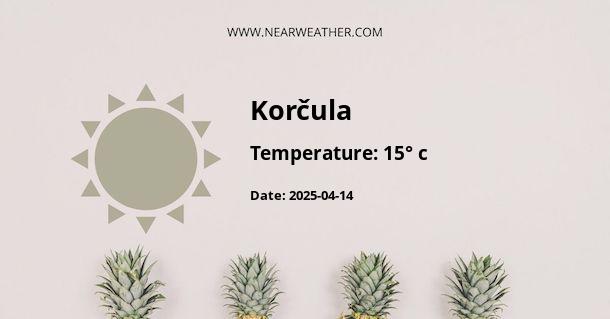An In-Depth Exploration of Korčula, Croatia's Climate and Weather Patterns
Welcome to an in-depth analysis of the climate and weather patterns of Korčula, a picturesque island located off the Dalmatian coast in Croatia. This enchanting island is renowned not only for its stunning beauty but also for the unique climatic conditions it experiences throughout the year. The following content aims to provide a comprehensive understanding of Korčula's climatic nuances, attractively laid out with the tactful use of HTML markup designed to enhance readability and engagement.
Overview of Korčula's Climate
Set in the Adriatic Sea, Korčula is graced with a Mediterranean climate that features mild, wet winters and hot, dry summers. This climatic pattern conforms to the Köppen climate classification as Csa, characteristic of coastal regions of the Mediterranean.
Temperature Patterns Year Round
| Month | Average High (°C) | Average Low (°C) |
|---|---|---|
| January | 11 | 5 |
| February | 12 | 6 |
| March | 14 | 8 |
| April | 17 | 11 |
| May | 22 | 15 |
| June | 26 | 19 |
| July | 29 | 22 |
| August | 29 | 22 |
| September | 25 | 18 |
| October | 21 | 14 |
| November | 16 | 10 |
| December | 12 | 6 |
The table reflects the typical Mediterranean pattern where summer months—from June to August—provide ideal conditions for beach activities and sailing, with temperatures often reaching the high 20s on the Celsius scale. Conversely, winter months, particularly from December to February, bring cooler temperatures that rarely dip below freezing, making the island an appealing winter retreat as well.
Precipitation and Humidity
- Monthly Average Precipitation: Korčula has higher precipitation in the colder months, peaking around November. Average monthly precipitation ranges from 40 mm in July to 119 mm in November.
- Humidity and Comfort: Typically, humidity levels throughout the year remain moderately comfortable, influenced primarily by the surrounding Adriatic Sea. Summer months experience lower humidity levels, contributing to the pleasant summer weather.
Wind Patterns
The wind is a significant climatic feature for Korčula, presenting patterns that sailors and windsurfers particularly treasure:
- Mistral: This northwest wind is prevalent during the summer and is welcomed for its cooling effect during the hot afternoons.
- Jugo (Sirocco): A southeast wind associated with rain, Jugo is more common in autumn and spring and is known for its humid and warm characteristics.
- Bura: Coming from the northeast, this cooler and sometimes strong wind often brings clear weather. It is most frequent in winter and can significantly impact temperature perception.
These winds not only influence recreational activities but are also integral to Korčula's viticulture, dispersing humidity and safeguarding vineyards from pests and diseases.
Sea Temperature Variances
Given that Korčula is an island destination, the Adriatic Sea's temperature plays a crucial role in the tourism dynamics:
- Swimming Season: Typically extends from May through October, with sea temperatures ranging from a pleasant 18°C in May to about 25°C in August.
- Off-Season Activities: Even outside the prime swimming months, the sea maintains a temperature that is relatively mild, particularly when compared to the chillier seas of northern Europe.
Best Time to Visit
Identifying the best time to visit Korčula depends on tourists' intended activities:
- Beach and Sailing: Late June to early September offers the optimal climate for sunbathing, swimming, and sea sports.
- Hiking and Cycling: The shoulder months of May, June, September, and October present the ideal conditions—neither too hot nor too cold.
- Cultural Exploration: April through October sees a vibrant social calendar, with various festivals and events showcasing Korčula's rich cultural heritage.
Climate Challenges and Phenomena
While Korčula's climate is generally temperate and inviting, it is not exempt from natural challenges:
Occasionally, the island experiences high water levels—particularly during autumn and spring storms. Despite such phenomena, the island's infrastructure and community are well-accustomed to typical weather patterns, ensuring a resilient response to climate-related challenges.
Climate Change Consideration
The broader discourse on climate invariably touches upon the changes islands like Korčula may face. While researchers continue to monitor patterns, a concerted effort towards sustainable tourism and environmental protection is critical to preserving the island's weather patterns and natural beauty.
Conclusion
In conclusion, Korčula offers a delightful climate that caters to a host of activities and tourism interests. With its mild winters and hot, dry summers, visitors can enjoy the natural beauty and cultural experiences the island provides throughout the year. Understanding Korčula's intricate weather patterns enhances visitors' ability to plan their trips and partake in the island's offerings in an informed and conscious manner.
To prepare for a trip to Korčula or to plan activities around its climatic conditions, access to up-to-date weather forecasts and historical climate data can be invaluable. Resources such as local meteorological services, climatological research, and online forecasting platforms serve to equip visitors and residents alike with the knowledge necessary to fully appreciate and harmonize with the rhythms of Korčula's climate.
Whether you're charting a course for a summer sail, eager to bask in the gentle sun of the shoulder seasons or interested in the seasonal festivities that light up the island year-round, Korčula's weather contributes immensely to the mosaic of experiences this Croatian gem has to offer.
A - Korčula's Latitude is 42.962219 & Longitude is 17.136940.
A - Weather in Korčula is 15° today.
A - Climate Conditions in Korčula shows moderate rain today.
A - Humidity in Korčula is 75% today.
A - Wind speed in Korčula is 48.06 km/h, flowing at 118° wind direction. today.
